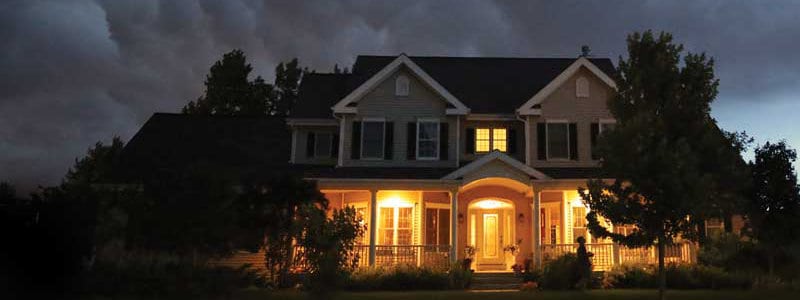Air Cooled vs Liquid Cooled Generator
Backup power during an outage maintains comfort while it keeps home and family safe, prevents business losses, and may allow a business to remain open during an extended outage. An Automatic Standby Generator, sometimes called a backup generator, is an automatic generator that provides backup power during an outage. They “stand by” waiting for a power outage. When it happens, the generators start automatically and switch the home or business to generator power. No human intervention necessary.
Standby Generators for homes and businesses fall into two main classes: air cooled and liquid cooled. The cooling refers to how the engine cools itself. Air Cooled Generators are the choice of many homeowners, but also fit the needs of some small businesses. Commercial Standby Generators offer the reliability and longevity required by operations from retail to farming.
The Best Whole House Natural Gas Generator
A generator engine converts fuel to mechanical energy which turns an alternator to generate electricity.
Power capacity is determined by the alternator capability and engine size. As the power drawn from the alternator increases, the load on the engine also increases and it uses more fuel. Generator manufacturers provide ratings in running watts and starting watts. Running watts equals the maximum continuous capacity of the generator. Starting watts, also called Surge Watts, is the maximum power the generator can produce for a few seconds to start motors or power large inductive loads like transformers.
For example, the air-cooled Generac 7043 22 kW Generator has a rated capacity of 22,000 running watts. It can provide 22kW all day. The engine in the 7043 has the power to turn the alternator while the generator supplies the maximum rated load. It must also have the power to provide the high starting current when it starts a heavy load like an air conditioner motor. For a few seconds, the starting watts of a 5-ton air conditioner could be 20,000 watts or more.
If the home or business is already drawing 14,000 watts from the generator, starting a 5-ton air conditioner adds a momentary 20,000 watts to the load for one or two seconds as the motor starts. The air conditioner load then falls to 7000 watts.
What is an Air Cooled Generator?
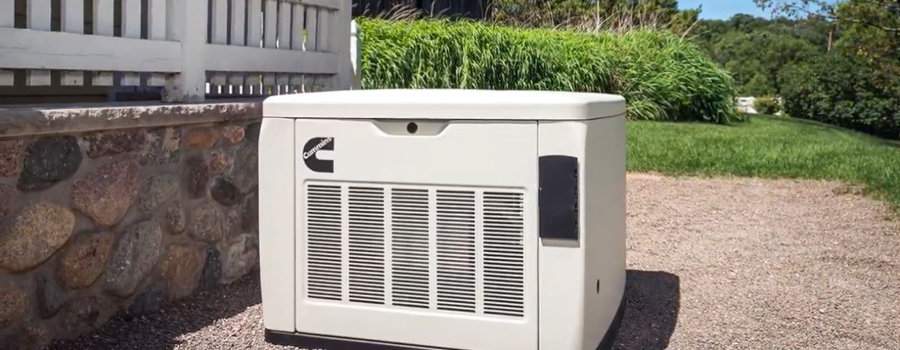
An air cooled generator uses air to cool the engine. Passive air cooling simply radiates heat into the surrounding air via fins on the engine cylinder head. As it rises or the wind blows it away, more air moves in and removes more heat. Passive cooling may provide enough heat removal for an open frame generator like a portable.
Standby generators have forced air cooling. A fan blows air over the generator engine to remove more heat. Manufacturers equip air cooled generator models with a one or two-cylinder engine less than one liter (1000cc) in size. The engine turns the cooling fan in addition to the alternator. It is efficient and suitable for moderate climates where temperatures rarely rise above 100° F.
Power Outage: Adaptation as Important as Preparation
Generator manufacturers have improved air flow and heat removal to ensure reliable operation in hot climates.
Air Cooled Generac 24kW Generator with 200-Amp PWRview ATS
The Liquid Cooled Generator Difference
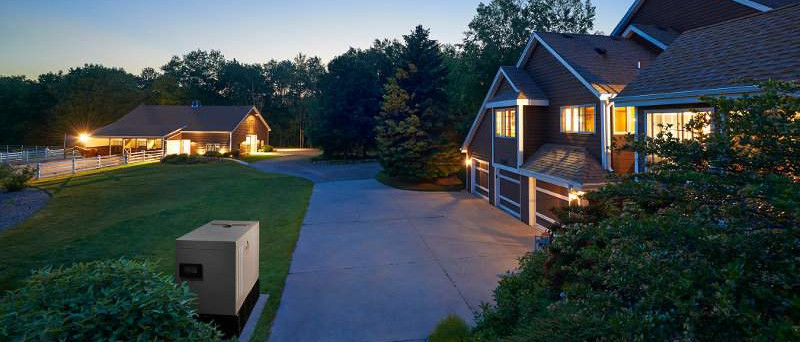
A liquid-cooled engine pumps a coolant through the engine block where it absorbs heat from the engine before it enters a radiator. A fan blows air through the radiator to remove heat from the coolant, which then returns to the engine and the cycle repeats. Air blowing through the radiator may blow over the engine to remove additional heat.
Not only does a liquid cooled generator engine turn the alternator, it must also pump the coolant and turn the fan. These functions require additional power from the engine.
Some refer to a liquid-cooled generator as a Water Cooled Generator—another name for a generator that uses a liquid coolant that is part water. Water Cooled Generators use a mix of coolant and water to raise the boiling point of the coolant above 212 degrees and to prevent it from freezing in cold weather.
Brutal Relentless Heatwave Brings Record-Breaking Temperatures
The liquid cooled generator has two advantages over air-cooled models. Liquid cooling is more efficient. The coolant can still remove heat even at the extreme temperatures inside the engine. It is not unusual for engine coolant to exceed the boiling point of water. This efficiency allows the generator to operate in hot climates where temperatures often exceed 100 degrees and may climb much higher.
A liquid cooled generator can use a larger engine than an air cooled, which allows the generator to produce more power. The largest air-cooled standby available is 24kW, a big step ahead of 20kW competitors, but doesn’t compare to a 150kW generator for very large estates, agricultural operations, or businesses.
Liquid Cooled Standby Generator Liquid Cooled Commercial Mobile Liquid Cooled Portable Generator
Air Cooled Generator Advantages vs Liquid Cooled
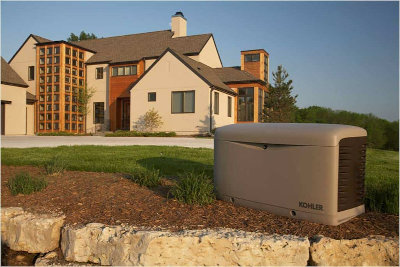
An air-cooled generator is less complex, usually has a smaller engine, and weighs much less than a comparable liquid-cooled system. The smaller engine and lower overall capacity (in general) lower the purchase price. Easy to move with a cart. Two people can install the generator in one day. It sits directly on the soil or a concrete Generator Pad at additional cost. In either case, the installer levels the site and places the pad directly on the ground with the generator on top. Installation costs less and takes less time. Air-cooled generators typically use less fuel than liquid-cooled counterparts. Most air-cooled generators are certified for installation at 18 inches from the building.
Determine the Right Fuel for Your Standby Generator
Liquid cooled generators can weigh three or four times the weight of an air-cooled model. They require power equipment to move and place the generator. The additional weight requires a prepared bed or pedestal to place the generator on.
The overall size, placement, and installation costs of liquid-cooled generators give the air-cooled an advantage. Some liquid-cooled models require five feet of clearance to the building. With a 50 percent larger footprint than air-cooled models, the larger generators use up valuable space in a backyard instead of fitting into the landscape. Distance from the building becomes additional landscaping repairs and higher costs for plumbing and electrical work.
The Best Standby Generators for Cold Climates
Liquid Cooled Generator Advantages

Liquid-cooled power capacity starts at 15kW for Diesel and 22kW for natural gas or propane. Air-cooled generators start at 7.5kW and max out at 26kW.
Manufacturers may rate air-cooled generators at a lower capacity for natural gas than propane, in part due to the limitations of the smaller engines. The larger engines found in liquid cooled models make up the difference and provide the same performance on either natural gas or propane. For example, the air-cooled Generac 22kW Generator has a 19.5kW rating on natural gas and 22kW on propane. The Generac 25kW Liquid Cooled Protector is rated at 25kW on natural gas and on propane.
Liquid Cooled Generators have a clear advantage in hot climates, especially the desert Southwest. When temperatures climb over 120 degrees, air-cooled generators may struggle to cool themselves enough to prevent shutdown. This additional reliability makes liquid cooled more suitable for business applications or critical systems that must run during a power outage.
The Best Standby Generators for Hot Climates
Bottom Line
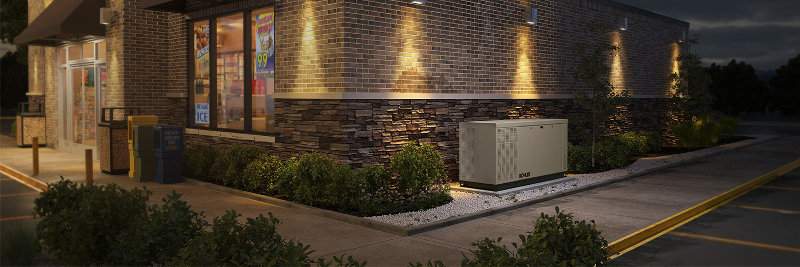
Both types of generators have their place. Air-cooled generators are fuel efficient and economically priced. They fit the average home in a moderate or cool climate where temperatures rarely rise over 100 degrees Fahrenheit. Businesses with power needs similar to a moderate to large home will also find the air-cooled models a good choice, especially where installation space is a consideration. Several air-cooled 3-phase generators are available from Generac, Kohler, and Briggs and Stratton. With few exceptions, 3-phase power is limited to business applications or large residential buildings.
Choose the Right Generator for Your Business
Larger homes and businesses that need more power or anyone in a hot desert climate should consider a liquid cooled generator. Superior cooling and power capacity that reaches far beyond the limits of air-cooled generators make the larger generators a natural choice for these applications.
Natural gas, diesel, and propane liquid-cooled generators provide fuel choices for anyone who needs backup power during an outage.
Guide to Choosing a Liquid Cooled or Air Cooled Generator
Updated by MJ Logan October 17, 2025

